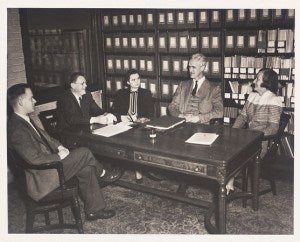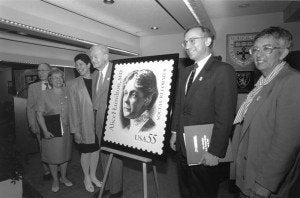The forerunner of the department of Environmental Health was the Harvard-MIT Institute of Technology School for Health Officers, which was established in 1913. Since that time, this department has accounted for a major part of the innovation and discovery that comprises the history of industrial health in the United States. Indeed, much of the earliest literature on industrial hygiene, industrial toxicology, and occupational medicine in this country originated at Harvard.
The research record of the Environmental Health Department (and its predecessors) has a distinguished history and encompasses a number of outstanding personalities and accomplishments. Dr. Cecil K. Drinker became a pioneer in industrial medicine and was among the first to emphasize the importance of the respiratory tract as the route of absorption for toxic dust and fumes. He proved to be a strong advocate for the establishment of industrial hygiene and applied physiology as disciplines in preventive medicine.

His brother, Dr. Philip Drinker, directed a program in ventilation that applied engineering principles to measurement of air flow. His work resulted in the development of the Drinker Respirator, or “iron lung,” one of the most dramatic inventions in the history of industrial hygiene.
Dr. Alice Hamilton, Harvard’s first woman professor, achieved major accomplishments in industrial hygiene and toxicology. Her research in understanding carbon monoxide poisoning and mercury poisoning resulted in the first state legislation aimed at safeguarding workers’ health.

By 1939, the department — called the Department of Industrial Hygiene at the time — was staffed with a significant group of scientists and engineers. Their war-orientated work included the development of oxygen equipment for high-altitude flight and its physiological evaluation; a protective gas mask to meet the needs of chemical warfare; heating, ventilation and air conditioning systems and a national health education program for shipyard workers.
In 1946, the department focused on peacetime research and teaching introducing newer specialties of radiological health and air pollution control. Department faculty served as consultants to the Atomic Energy Commission and, as a result, radiation protection, aerosol physics, and air and gas cleaning technology gained greater prominence in teaching programs. In 1947, Dr. Ross McFarland, a noted researcher in aerospace medicine, joined the department and developed a certificate program in aviation medicine.
By the mid-1950’s, the Department of Industrial Hygiene had enlarged its curriculum and research efforts to include radiological safety and air-pollution control in addition to the more traditional studies of industrial hygiene, industrial medicine, industrial safety and environmental sanitation.
The Departments of Industrial Hygiene, Physiology, and Sanitation Engineering were grouped under a single Division of Environmental Health and Engineering Sciences led by Dr. James L. Whittenberger. Later this division became part of the new NIEHS-funded Kresge Center for Environmental Health at the school.
In 1962, Leslie Silverman and Melvin First launched a new field of studies on solid waste management continuing the enlargement of the scope of concern related to environmental health management and to environmental health problems. In the mid-1960’s the department continued its historic interest in the relationship between occupational exposures and occupational disease with research efforts aimed at identifying new job-related hazards and bringing them under control. These included studies of toluene di-isocyanate (TDI) and lead toxicity, evaluations of health hazards involved in fire fighting and rubber tire manufacturing, respiratory disease in granite cutting, talc mining, and meat packing and mortality in a number of different types of manufacturing in Massachusetts.
Early in the 1970’s the department played a signal role as a non-partisan participant in environmental research of vital concern to differing societal groups: industry, government, consumers and workers. A pioneering agreement with the United Rubber Workers and the BF Goodrich Company paved the way for similar three-way agreements with labor and management at the School and elsewhere.
In 1973, Department faculty Benjamin Ferris and his colleague Frank Speizer proposed what was to become one of the most influential, innovative and longest-running studies concerning the health effects of air pollution in America: The Harvard Six Cities Study. The work, which continues to this day, set a standard for research in air pollution that is emulated throughout public health and around the world. Current Department Chair and epidemiologist Douglas Dockery joined the project in 1974 and directed the study’s attention to particulate matter, now recognized as a dangerous form of air pollution.
This study, released in 1993, led to the regulation of airborne particulate matter. In the laboratory of past department chair Joseph Brain, dust from the study’s filters has been used in animal models to study pulmonary disease. This study and numerous spin-off studies continue to yield data that strongly influence the direction and content of American air quality policy, including the adoption of standards that restrict emissions of smaller particulate matter than originally included in regulations and the recognition of indoor air pollution as a significant contributor to health problems. The Six Cities study data are considered to be one of the bedrocks of the Clean Air Act.



